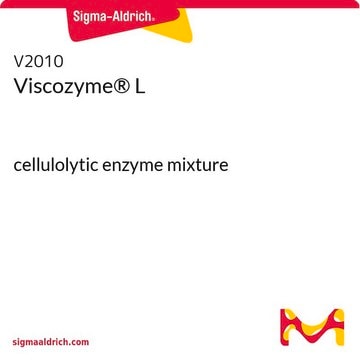C8546
Cellulase from Trichoderma reesei ATCC 26921
lyophilized powder, ≥1 unit/mg solid
Sinónimos:
1,4-(1,3:1,4)-β-D-Glucan 4-glucano-hydrolase
About This Item
Productos recomendados
form
lyophilized powder
specific activity
≥1 unit/mg solid
greener alternative product characteristics
Waste Prevention
Design for Energy Efficiency
Learn more about the Principles of Green Chemistry.
sustainability
Greener Alternative Product
solubility
deionized water: soluble 5.0 mg/mL (Sterile; In the presence of 0.15% polyhexamethylene biguanide (PHMB).)
greener alternative category
storage temp.
2-8°C
Categorías relacionadas
General description
Application
Biochem/physiol Actions
Unit Definition
Preparation Note
Other Notes
substrate
signalword
Danger
hcodes
Hazard Classifications
Resp. Sens. 1
Storage Class
11 - Combustible Solids
wgk_germany
WGK 1
flash_point_f
Not applicable
flash_point_c
Not applicable
ppe
dust mask type N95 (US), Eyeshields, Faceshields, Gloves
Certificados de análisis (COA)
Busque Certificados de análisis (COA) introduciendo el número de lote del producto. Los números de lote se encuentran en la etiqueta del producto después de las palabras «Lot» o «Batch»
¿Ya tiene este producto?
Encuentre la documentación para los productos que ha comprado recientemente en la Biblioteca de documentos.
Los clientes también vieron
Protocolos
To standardize an enzymatic assay procedure of cellulase.
Nuestro equipo de científicos tiene experiencia en todas las áreas de investigación: Ciencias de la vida, Ciencia de los materiales, Síntesis química, Cromatografía, Analítica y muchas otras.
Póngase en contacto con el Servicio técnico







